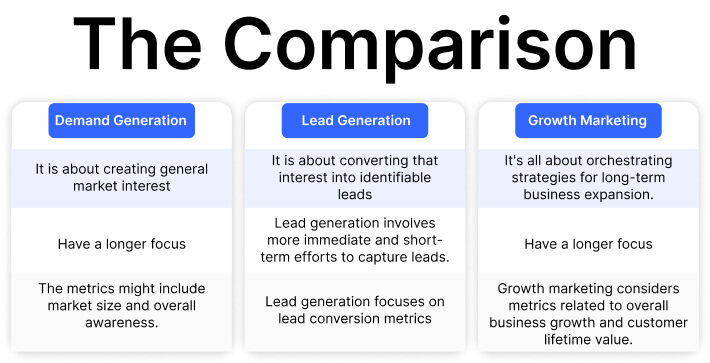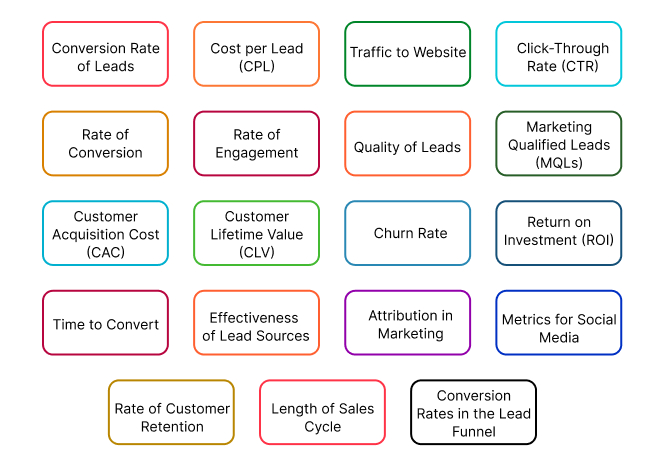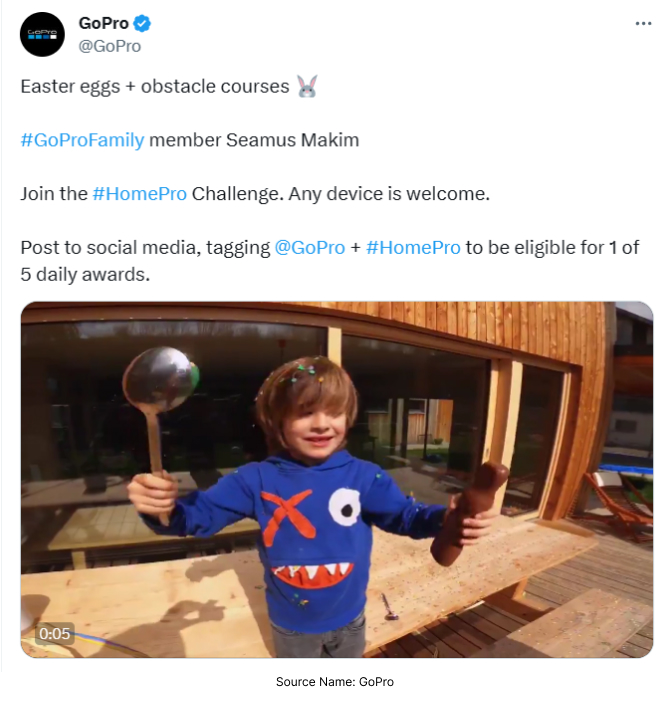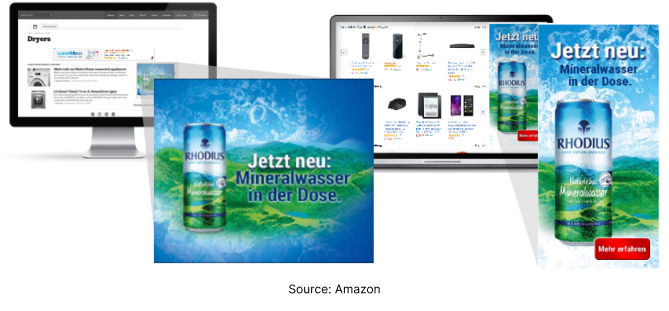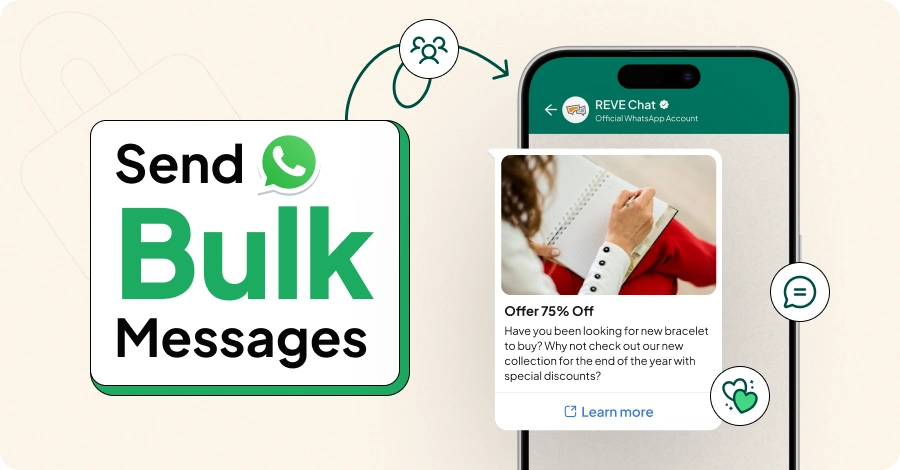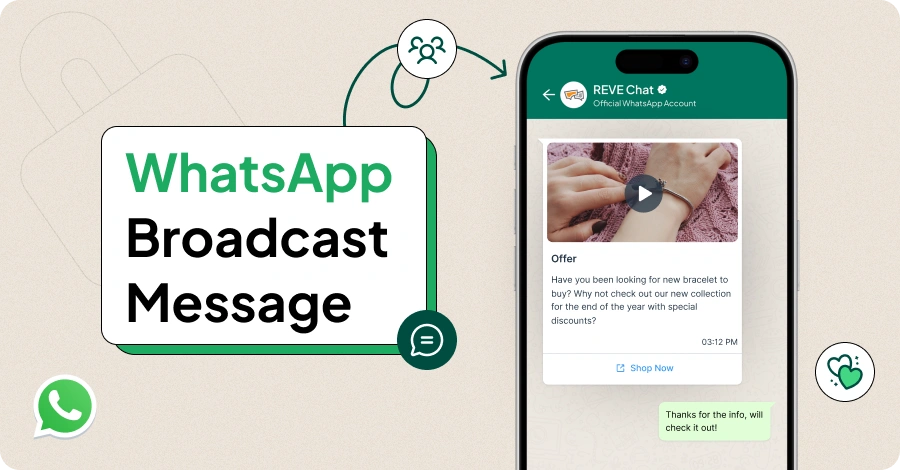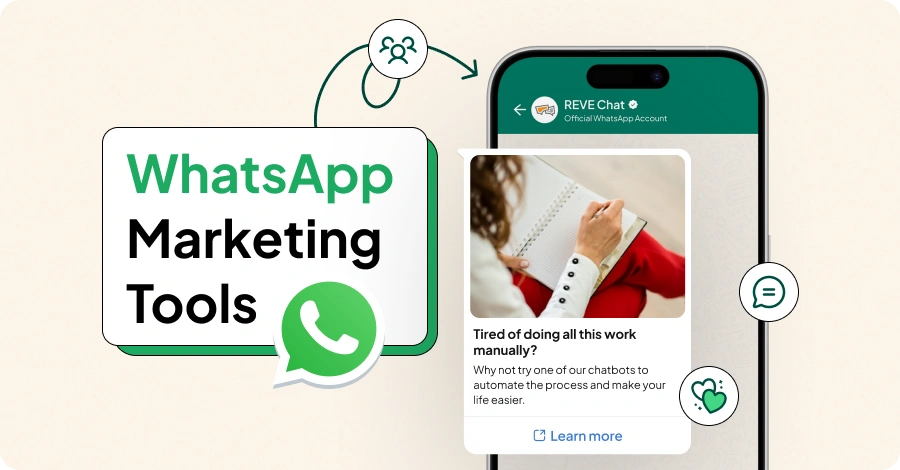What is Demand Generation Marketing? Benefits & Strategies
- December 28, 2023
- 23 mins read
- Listen

Table of Content
Today, brands face a big challenge: making people want their products and services. That’s where demand generation marketing, or “demand gen,” comes in. It’s a well-known concept for business-to-business (B2B) and business-to-consumer (B2C) companies.
But let’s be clear – demand generation isn’t about forcing people to want things or tricking them into buying unnecessary stuff. It’s about giving the right info to the right folks at the right time, knowing that what you’re offering is exactly what your customers need.
Unlike lead generation, which is quicker, demand generation takes more time. It involves various touchpoints, campaigns, and offers – basically, anything your brand does to create excitement, awareness, and recognition.
The ultimate goal? Sparking better conversations between buyers and sellers, leading to more successful deals and higher conversion rates.
Creating effective demand-generation marketing may not be a breeze, but we’re here to help break it down for you. While obstacles are in the way, the good news is there are many ways to overcome them.
In this blog, we’ll take you step by step through the challenges you might face, the secrets to conquering them, the goals and steps that drive successful demand generation, and why putting in the effort for good demand generation is truly worthwhile. Finally, we’ll give you a glimpse of what successful demand generation marketing looks like in the real world.
Are you ready to get some knowledge on this? Let’s get started!
What is Demand Generation Marketing?
Imagine you have a delicious new ice cream flavor that you want everyone to try. Demand generation marketing is like shouting from the rooftops, “Hey, we’ve got this amazing ice cream – you don’t want to miss out!”
In simpler terms, demand generation is all about creating excitement and interest in your product or service. It’s not just about selling; it’s about sparking curiosity and making people say, “I need to have that!”
So, demand generation involves activities like social media campaigns, catchy ads, and other creative ways to grab attention. It’s the art of making potential customers aware of your awesome ice cream and convincing them that they absolutely must taste it. Remember, it’s not just about having a great product; it’s about getting people excited to experience it for themselves. That’s demand generation marketing in a nutshell – making sure everyone knows about your fantastic ice cream and can’t resist giving it a try!
In the B2B business world, demand generation is the secret sauce to staying memorable during the quiet times – when potential customers aren’t actively buying stuff. The trick is to make sure your product or service is the first thing they think of when they suddenly realize they need it.
What makes demand generation special? It’s not a quick fling; it’s a long, committed relationship. While others go for quick wins, demand generation is playing the long game. It’s making sure your brand is the trusted choice when the right time comes.
Benefits of Demand Generation Marketing
Nailing demand generation is like hitting the jackpot – you score more leads and more people fall in love with your product. And guess what? The perks of a killer demand generation campaign go beyond just leads. Now let’s talk about the perks and the cool stuff it brings to the table:
-
Big Savings Alert!
Brands often splash out a ton of cash just to keep customers hanging around. But demand generation programs can swoop in, build up a stellar reputation early on, and slash those smaller costs down the marketing road. Picture this: if a brand is seen as the go-to, trustworthy expert in its field, it’s like building a fan club that sticks around. And here’s the cool part – it not only keeps the current customers happy but also makes future marketing campaigns more effective and budget-friendly.
-
Brand Reputation & Public Awareness
A well-designed demand generation campaign not only markets your product or service but also introduces your brand to a new audience. Instead of solely focusing on making a sale, the aim is to integrate your brand into the customer’s life meaningfully.
During the initial stages of demand generation, your brand’s reputation isn’t just about making sales; it’s about becoming a trusted guide in your customers’ everyday lives. This good reputation can boost your brand’s credibility, showcasing it as a leader through things like case studies and webinars.
-
Stand Out and Win: Unleashing Your Competitive Edge!
In the world of business, it’s not just about being good; it’s about being outstanding. Effective demand generation marketing is your secret weapon to make your brand shine brighter than the rest. Picture this: by putting your unique strengths on display and tackling the challenges that keep your audience up at night, you’re not just competing — you’re winning the race. Embrace your uniqueness, address those pain points, and let your brand soar high with a competitive advantage that turns heads and seals the deal!
A Closer Look at Demand vs. Lead Generation vs Growth Marketing
Demand generation, lead generation, and growth marketing are related concepts, but they differ in their primary focus, scope, and objectives within the overall marketing and business strategy.
1. Demand Generation:
- Focus: Demand generation is primarily focused on creating awareness and interest in a product or service within a target market.
- Scope: It encompasses a broader set of activities that aim to stimulate and capture the interest of potential customers. This includes content marketing, brand building, public relations, and advertising.
- Objective: The main goal is to generate and nurture interest at the top of the sales funnel, creating a pool of potential customers.
2. Lead Generation:
- Focus: Lead generation narrows its focus to identifying and capturing potential customers (leads) who have expressed interest in a product or service.
- Scope: It involves specific tactics and strategies to attract and convert prospects into leads, often utilizing channels like social media, email marketing, and content marketing.
- Objective: The primary goal is to fill the sales funnel with qualified leads, providing the sales team with individuals who are more likely to convert into paying customers.
3. Growth Marketing:
- Focus: Growth marketing takes a holistic approach that goes beyond traditional marketing. It involves strategies for achieving sustainable business growth through a combination of marketing, product development, and customer experience.
- Scope: It considers the entire customer journey, from acquisition to retention, and often involves cross-functional collaboration between marketing, product, and customer support teams.
- Objective: The primary goal is to drive continuous, scalable, and sustainable business growth, going beyond the immediate acquisition of leads.
Tackling the Top 6 Challenges in Demand Generation
Demand generation is like the magical bridge that brings your sales and marketing teams together, creating a fantastic harmony for some serious growth. Yet, managing all the marketing and sales tasks, starting from the first hello to keeping clients happy and encouraging them to buy more, is no walk in the park.
Let’s dive into the usual challenges marketers face when they aim for an all-encompassing strategy that covers everything – attracting new customers, ensuring their loyalty, and boosting those extra purchases.
1. Your Website Fails to Draw in Visitors
Imagine your online shop is like a quiet street with no shoppers. The challenge here is that not enough people are finding or visiting your website.
This may stem from issues such as poor visibility in search engines, unoptimized content, or a lack of effective marketing strategies. Without a steady stream of visitors, your website will miss opportunities for engagement and conversion.
2. You Don’t Understand the Target Audience
It’s a bit like trying to plan a surprise party without knowing what the guest of honor likes. The challenge is not fully getting who your customers are. If you don’t understand their interests and needs, it’s tough to connect with them in a way that really clicks.
This can result from insufficient market research or a lack of data analysis. Without a clear picture of the audience’s needs, preferences, and behaviors, your demand marketing efforts may miss the mark, leading to ineffective communication and engagement.
3. Your Website Lacks Avenues for Conversion
Think of your website as a store with no checkout counter. The challenge is that visitors might be interested, but they’re not easily turning into customers. It’s like having items in the cart but struggling to check out.
When a website lacks clear paths for conversion, users may face obstacles in progressing from initial interest to taking desired actions. This challenge could be attributed to a confusing user interface, a lack of compelling calls-to-action, or an absence of strategic placement for conversion elements. As a result, the website may struggle to turn visitor interest into tangible outcomes.
4. Leads are not Converting
Turning leads into customers can feel like having friends at your door who hesitate to step inside. The challenge lies in persuading these interested individuals to take the next step, which is important for transforming their curiosity into actual sales.
The challenge of converting leads into customers is a critical aspect of the sales funnel. This issue may arise due to ineffective lead nurturing strategies, unconvincing communication, or a misalignment between customer expectations and the offerings. Without successful lead conversion, the business may experience stagnation in growth.
5. Keeping the Customer Love Alive
Retaining customers is a bit like maintaining a friendship. The challenge is to keep them happy and engaged. If you’re not doing that, they might wave goodbye and head to another shop.
This may be due to factors such as inadequate post-purchase support, unaddressed customer concerns, or a lack of personalized experiences. Without effective retention strategies, businesses risk losing customers to competitors and may find it challenging to build long-term relationships.
6. Tracking and Measuring Results have Become Tough
The challenge here is not being able to measure how well your efforts are working. If you can’t see what’s happening, it’s tough to know what’s going right and what needs a little extra spice.
Difficulties in tracking and measuring results can arise from inadequate analytics tools, a lack of key performance indicators (KPIs), or data fragmentation. Without a clear understanding of the impact of demand generation marketing efforts, businesses may struggle to optimize their strategies, allocate resources effectively, and make informed decisions for future campaigns. This challenge hampers the ability to gauge the success and ROI of various initiatives.
Stages of Demand Generation Marketing: How Does It Work?
Demand generation marketing is a bit complicated process, and you truly plan strategically to make it work. Whatever you are planning to do, you need proper understanding and research behind that. For example, in case of content marketing, you can not create any content for your customers. You need to research and find out what type of content will be beneficial for your audience.
In short, in case of demand gen marketing, you need to plan step by step. Here are the basic stages to follow:
Step 1: Understand who are your target audience and their struggles.
Step 2: Find out what are the perfect digital channels for your business to run the demand generation program campaigns.
Step 3: Set proper objectives for your business.
Step 4: Develop an effective content strategy to send the right message to your customers at the right time.
Step 5: Invest in demand generation tools to measure the effectiveness of your marketing campaigns.
Step 6: Optimize your demand generation strategies on a regular intervals to keep up with the changing trends and customer preferences.
Proven Demand Generation Tactics You Can’t Miss!
Generating demand involves handling various components, and once you’ve mastered the art of managing them effectively, it becomes a powerful tool for elevating your business. Here are some essential demand generation strategies to discover, acquire, and guide leads through your entire sales and marketing process.
1. Smart Objectives
Start with clarity and purpose. Smart objectives set the foundation for your demand generation efforts. They’re the lighthouse guiding your ship, ensuring you navigate towards meaningful, measurable, and achievable goals.
Imagine it as a roadmap — first, set smart goals in sales and marketing. Then, tie these goals to what your customers really need. This focused demand generation strategy helps you walk in the right direction.
But, here’s the catch: goal setting- can be tricky. Your goals must be specific, measurable, achievable, relevant, and time-bound — we call these “SMART goals.” If your goals are too vague, hard to track, or impossible to reach, they won’t spark the motivation your team needs.
Pro Tips:
- Clearly define your objectives with precision.
- Ask yourself: What exactly do you want to achieve? Who is involved? What resources are required?
- Confirm that your goals are both realistic and feasible.
- Align your goals with the broader objectives and strategy of your business.
2. Crafting Personas and Aligning with the Buyer’s Journey
Effective lead generation starts by creating detailed buyer personas. Collaborate with your sales and marketing teams, and supplement your insights with external research to gain a deep understanding of your ideal customers. Explore their goals, challenges, and how your solutions address their specific needs. Identify the messages that resonate most with them.
Once you’ve crafted three to four primary personas, blend external research with existing customer data to map out the buyer’s journey for each persona. Delve into questions like: What content would genuinely assist my personas at various stages of their buyer’s journey? What content is so valuable that they would willingly share personal information to access it? Utilize these insights to shape and enhance all your lead generation strategies.
Harmony between your marketing and sales departments is crucial for creating precise and comprehensive personas. By aligning these teams, you pave the way for a more effective and targeted lead generation approach.
Pro Tips:
- Engage both your sales and marketing teams in the persona creation process.
- Conduct interviews or surveys with existing customers to gather firsthand information about their needs, preferences, and pain points.
- Utilize data from customer interactions, purchase history, and website analytics to identify patterns and behaviors.
- Extend your research beyond internal data. Explore industry reports, market trends, and competitor analyses.
- Clearly define and map out the stages of your buyer’s journey.
- Identify the types of content that resonate at each stage of the buyer’s journey.
- Regularly review and update your personas and content strategies to stay in tune with evolving customer needs and market trends.
3. Search Engine Optimization (SEO) and Search Engine Marketing (SEM)
In the digital landscape, visibility is all that matters the most, and SEO and SEM play pivotal roles in ensuring your brand is easily discoverable. SEO involves optimizing your website to rank higher in organic search results, while SEM involves paid advertising to increase visibility.
To attract the right customers, make sure your website is super search-friendly, with top-notch keywords and maybe some ads too. First, figure out who your ideal customers are, and then pick the words they’d use to find your products. Sprinkle those words throughout your website, in the title, and even in the behind-the-scenes details.
Build up your website’s authority by creating pages about key topics related to your business. If you decide to run ads, be smart about it – show them to the people who are actually interested. And don’t forget to keep your website content in tip-top shape by regularly checking and improving it. Google’s pretty smart now, so your strategy should be too, considering what people are really looking for.
Pro Tips:
- Regularly conduct keyword research to identify relevant terms and phrases your audience uses.
- Ensure your landing pages are SEO-friendly and align with the keywords you’re targeting.
- Produce high-quality content that not only attracts but also engages your audience.
- Stay updated with search engine algorithms and adjust your strategies accordingly.
- Optimize for local searches, especially if your business has a physical presence.
4. Crafting Strategic Content
If you’ve been checking out inbound marketing, you’ve probably heard that “content is king” – and it’s totally true! Whether it’s videos, blogs, checklists, or emails, content is super important for grabbing people’s attention and getting them interested.
Take another look at your buyer personas. What kind of information are they searching for? What content would be most useful for them? How do they like to receive this information? Craft or adapt authentic, pertinent, and helpful content with the aim of enlightening your potential customers and providing them with the tools to make well-informed choices.
Pro Tips:
- Understand your target audience’s needs, preferences, and challenges and tailor your content accordingly.
- Experiment with various content formats such as videos, blogs, infographics, and podcasts. Different people prefer consuming information in different ways, so offering a variety keeps your audience engaged.
- Incorporate storytelling into your content.
- Create content that is well-researched, informative, and adds value to your audience.
5. Optimizing Conversions
By really knowing who your ideal customers are, sharing lots of helpful content that boosts your brand, and using SEO to bring quality visitors to your website, you’re well on your way to getting more leads. But there’s one more thing to do: make sure your website is set up to turn visitors into customers.
Take a smart, data-driven approach to figure out the best ways to guide each type of customer through your website. Start with easy-to-access, useful content, then lead them to special offers with persuasive prompts, and finish with forms and delivering what you promised. When you optimize your website like this, your potential customers can smoothly go through the whole buying process without needing extra help from you.
Pro Tips:
- Regularly update and refine your buyer personas based on ongoing data and customer feedback.
- Experiment with different elements like CTAs, forms, and landing page designs to identify the most effective combinations that maximize conversions.
- Utilize advanced analytics tools to track user behavior on your website. Gain insights into how visitors interact with your content and identify potential bottlenecks in the conversion process.
- Integrate marketing automation tools to streamline and personalize your lead nurturing process.
- Ensure your website and conversion pathways are optimized for mobile users.
- Incorporate social proof elements, such as testimonials, case studies, and user reviews, within your conversion pathways.
6. Support and Empowerment for Sales
Gone are the days when a marketer’s job was done after passing leads to the sales team. In today’s world, modern digital demand generation marketers team up with sales to guide leads through every stage, provide assistance, and create a complete plan for closing more deals and keeping happy customers.
Ensure your sales and marketing squads agree on what each stage of a customer’s journey looks like. Have regular meetings to talk about any ideas or challenges that pop up. Use the info you’ve gathered from your leads to share content that’s just right for them. Craft helpful sales materials like case studies, tutorials, demo videos, and assessments to help your sales team show off how great your product or service is. It’s all about working together to make sure everyone is on the same page and ready to win!
Pro Tips:
- Implement a closed-loop communication system where feedback flows seamlessly between marketing and sales.
- Invest in an integrated technology stack that allows seamless data sharing between marketing and sales tools.
- Continuously refine lead scoring criteria based on feedback from the sales team.
- Form cross-functional teams comprising both marketing and sales representatives for specific campaigns or initiatives.
- Celebrate successes as a unified team.
Quantifying Impact: Measuring Success in Demand Generation
Launching a demand generation campaign is like sending a rocket into space—you’ve got a plan, you put in the work, and now you want to see how far it goes. But how do you know if it’s a success or needs a tweak? That’s where measurement comes in, like your trusty navigation system. In this part, we’ll delve into this topic. Consider it as your guide to figuring out whether your campaign is soaring high or could use a bit of extra power.
1. Clarify Key Performance Indicators (KPIs)
Before you can measure how well you’re doing, it’s crucial to know where to focus. To measure your success, start by setting specific key performance indicators (KPIs) that match your overall business or marketing goals. These KPIs are like the X marks the spot on our journey toward overall business success.
Now, here’s where the magic happens: imagine connecting these dots, linking our demand generation strategies to actual business growth. Once we’ve cracked the code on which KPIs matter most for our goals, it’s time to navigate the customer journey. This way, you can figure out which parts are giving you the most bang for your buck and help your business thrive.
Find out the important numbers for boosting your demand generation game! I’ve outlined below the important KPIs you should begin using.
2. Monitor Data Trends Over a Period
Discovering what catches the attention of your leads through data trends is key to refining your strategy for better results. Take a closer look at your conversion rates and how they align with your tactics. See if there’s a connection between these rates and your target audience.
Try out testing tricks to spot specific changes in your strategy and see what works best.
If you’re using a social media tool like Buffer or Hootsuite, dive into the analytics to track changes over time. Use this data to spot trends and learn how your audience engages with your brand. It’s like decoding what they love to see, so you can give them more of what they enjoy!
Demand Generation Best Practices
Demand gen marketing is not as easy as it sounds. You may face the challenges mentioned earlier if you don’t plan it properly. Here are some of the best practices to look into to achieve the maximum results.
- Find Out Your Target Audience: Understand your buyer persona. If you don’t know who are your actual target audience your timing, investment and all the marketing efforts will be wasted.
- Help Customers to Find Out Info Easily: Many times customers get frustrated when they can’t get the right information at the right time. To know more about your offerings, the website is the place where they land first. So, make it a point that it’s user-friendly and customers get the required info with ease.
- Your Teams Should Be on the Same Page: Both your marketing and sales teams are integral parts of demand generation efforts. So, aligning these two teams together is very important to get the maximum results. For example, after getting a quailed lead the marketing team should have information about how the sales team is approaching with the lead. At the same time, the sales team also should have an idea about the interactions the marketing team had with the prospect.
- Offer Valuable Content: You need to deliver useful content to the customers to increase brand awareness. So plan the structure, type of content and topic you are going to cover, and format that will be used beforehand. Also, your content strategy should be aligned with your business objectives.
- Leverage SEO: Use SEO to get the maximum results from your content marketing activities. Research what keywords your target customers are using while searching for products from your business category and incorporate those in your content to get higher ranks in the search results and better visibility.
Some more tips:
- Manage the development and publishing of your content on a regular basis through a content calendar.
- Engage with your customers through personal interactions, social media posts, webinars, and other networking events to build a strong relationship.
- Opt for lead scoring to prioritize potential leads over others.
Examples of Demand Generation Marketing
Here are three cool examples of demand generation campaigns to look into. These stories reveal the tricks behind grabbing attention, building excitement, and making people really want what you have to offer. From clever campaigns to smart content, these examples show how to make folks not just interested but super excited about what you’re doing.
1. GoPro
GoPro isn’t just selling cameras; it’s on a mission to capture the hearts of adventure enthusiasts and storytellers. Instead of bombarding people with technical details on social media, GoPro taps into the emotions behind its customers’ stories. By showcasing user-generated content in its demand generation campaign, it reveals how effortless and exciting it is to share experiences with a GoPro, skipping the hard sell. Even if you’re not shopping for a camera, GoPro’s ads spark curiosity in anyone yearning for a platform to share their own tales.
2. Rhodius
Rhodius, the canned water and beverage brand, set out on a mission: make more people aware and excited about its canned water. How did they do it? By teaming up sponsored ads with display ads, targeting folks looking into beverages. They got clever with custom segments, reaching out to those most likely to buy canned drinks online. Rhodius also lets its creativity shine in display ads, showing off what makes its brand special. The result? A whopping 120% increase in keyword searches and a huge 156% boost in organic impressions!
3. Zoom
Check out this snippet from Zoom’s infographic for a different way to get people excited about a brand! They keep it super clear with their branding (“Zoom + Chorus,” “Zoom video”), and the content is all about something people really care about: sealing the deal in sales. It’s a smart pitch that speaks to customers who are just getting to know Zoom (“How can I sell more?”) and those who are thinking about what makes Zoom special (“What’s different about Zoom compared to other video platforms?”).
FAQs on Demand Generation Marketing
1. How do small businesses benefit from demand generation marketing?
Any business, irrespective of the size, big or small can get benefitted from demand generation programs. Such marketing activities help them to spread the words, attract target audience in a better way and increase sales conversions. If the demand generation strategies are executed properly, small businesses also can compete with big players and stay ahead in the competition.
2. How can technologies help in demand generation?
Many automation tools help streamline the demand-generation processes. Tools like AI solutions, and CRM software help to track leads, personalize interactions, measure the effectiveness of different marketing activities, and automate other business operations including customer service.
3. Can you outsource your marketing demand-generation activities?
Yes, of course. There are many specialized agencies out there who can plan the whole demand generation marketing activities for you. Such initiatives give you more time to concentrate on your other business operations while the agencies will take care of the demand generation programs.
4. What is the role of customer feedback in demand generation?
Well, customer feedback plays a big role here. It gives you insight into your customers’ requirements, painpoints, suggestions, and how they are finding your product offerings. Based on such info, you can finetune your demand generation marketing activities to perfection.
5. What kind of content do I need to develop for my lead generation programs?
Different types of content will be required at each stage of your digital demand generation activities. Content can range from building awareness to encouraging consideration, and ultimately helping customers make their final decision.
Some content ideas include:
- Customer reviews
- Blogs
- Infographics
- Tutorial videos
- Whitepapers
Expect More from Your Marketing Efforts!
Demand gen marketing is like an ongoing adventure, not just a one-stop destination. Marketers must continually identify, nurture, and hand over leads to the sales team, then kick-start a new cycle to retain those valuable customers.
Tools like marketing automation platforms and CRM are your trusty companions on this journey, along with well-thought-out strategies for content marketing and advertising. With the right blend of people, processes, and technology, you can enhance your demand generation initiatives and ensure a steady flow in your marketing and sales pipeline.

